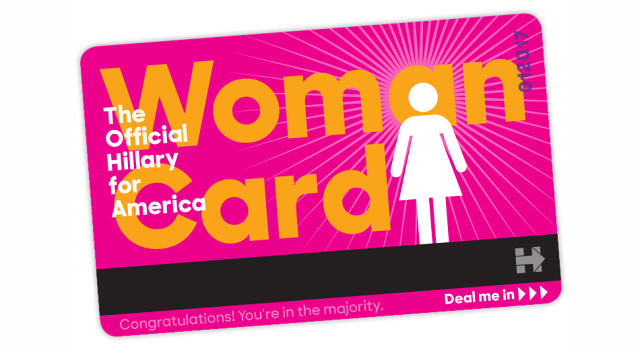Debunking The Myth Of The Woman Card In Silicon Valley
In one of the latest mudslinging remarks of this election season, Donald Trump claimed that Hillary Clinton was playing the “woman card,” implying that she only got to where she is in the race because of her gender. His remarks, “I think the only card she has is the women’s card . . . She has got nothing else going. Frankly, if Hillary Clinton were a man, I don’t think she would get 5% of the vote,” sent the message to his supporters that her womanness is somehow getting her approval despite an obvious incapacity to be president.
This phenomenon—accusing women of being able to get ahead professionally just because of their gender—isn’t new.
“There’s definitely people who will come right out and tell you, they think you got hired because you are a woman, or because you have darker skin color, instead of assuming that the place they work that is supposedly good at hiring, hired you because you’re also good,” says Erica Baker, a former engineer at Google and current engineer at Slack. “Someone at Google said it. Oh, you were probably hired because of affirmative action,” she continues. The idea of a woman card is not unlike the idea of the race card—or the perception that someone is hired not because of their talents, but because they’re fulfilling a quota.
While that may be a complaint in the workplace or online forums, statistics and studies show that people aren’t getting selected for jobs based on their skin color or gender alone. For one, if hiring qualifications rested squarely on these two characteristics, workplaces would probably already be a lot more diverse. They’re not. Staff at major companies like Google, Twitter, and Facebook are roughly 30% female.
Those same companies struggle to incorporate more women and people of color into their ranks through Rooney Rule-like diversity initiatives and unconscious bias training. A year after pledges to increase diversity, Facebook was only able to raise the number of women in its ranks by a mere 1%. Meanwhile a discrimination suit lobbed at Twitter from former employee Tina Huang revealed that gender disparity was far worse than the company’s already dismaying statistics let on.
While diversity initiatives are helping to improve the number of female employees ever so slightly, there’s no tide-turning shift that’s happening. “Companies won’t hire someone who isn’t the best person for the job because of their gender or any other diversity goal. A company may make an effort to interview women and be excited about the value diversity adds to a team, but they won’t hire someone unqualified to meet a diversity goal,” says Alaina Percival, CEO of Women Who Code.
It doesn’t make economic sense for a company to jeopardize their bottom line to accommodate diversity by hiring people who are unfit for a job. Whether executives are coming out and saying this is unclear. Regardless, the sentiment is being felt. In a Medium post, former Twitter engineer Leslie Miley recalled his superior, SVP of engineering Alex Roetter, allegedly telling him, “Diversity is important, but we can’t lower the bar.”

The idea that the tech industry or any workplace is guided by some sort of meritocratic compass that’s always pointing in the direction of the hardest workers has been widely debunked.
Research indicates women and minorities with resumes comparable to male candidates fare much worse when it comes to recognition inside the workplace.”What studies show is that women are actually judged by a higher standard and are more scrutinized and have to provide more evidence of their accomplishments and their competence to be seen as equally qualified as a man,” says Marianne Cooper, a sociologist at Stanford University’s Clayman Institute for Gender Research. To Cooper’s point, 2014 research from the American Management Association shows that female CEOs at Fortune 500 companies on the whole were better credentialed than male CEOs on the list. Keep in mind that women made up a mere 4.8% of Fortune 500 CEOs that year.
Research does show that women are held to a higher standard. It also indicates that male employees tend to get judged by more lenient standards. “What evidence we do have points to cultural stereotypes working in a way that advantage men and disadvantage women,” says Cooper.
For instance, a 2012 study examining bias in academic science found that faculty members who rated two equivalent job candidates, one male and one female, not only deemed the male candidate more competent than his female counterpart, but offered him a better overall hiring package, including higher pay and mentoring opportunities. The reason for this, Cooper explains, is that our brains are deeply tethered to stereotypes that say men are good at certain things and women are bad at those same things. “There are widespread cultural stereotypes that men are more competent than women, and it’s especially more prominent in traditionally masculine domains,” she says.
All this to say that Trump’s assertions are flat-out wrong: The woman card doesn’t exist. The data says that women don’t get hired for a job unless they’ve proved themselves capable multiple times over. Clinton is far from immune to this curse. Perhaps it could be said that Clinton, with her eight years as First Lady, two terms in Congress, and four years as secretary of state is more qualified for the presidency than others who have held the post, and certainly more qualified than a businessman with no political experience.
“In my experience, a woman only gets a position when she’s been doing that job for many years for less pay. And everyone already recognizes that she can do it, she’s been doing it. It just took way too long to get there.” says Jordan A. Smith, a designer based in Portland, Oregon. “It’s always overdue. I’ve seen it time and time again.”
Ruth Reader is a Brooklyn-based writer. She covers tech startups alongside issues of gender and diversity in the workplace. Find her on Twitter at @ruthreader.
Fast Company , Read Full Story
(47)












